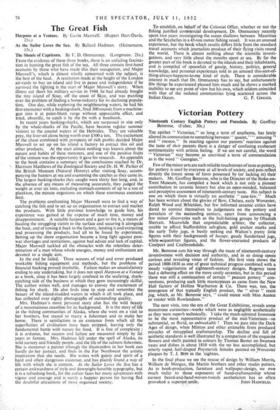Victorian Pottery
Nineteenth Century English Pottery and Porcelain. By Geoffrey Bemrose. (Faber. 30s.) THE epithet " Victorian," so long a term of anathema, has lately altered its connotation to something between" quaint," " amusing " and " rococo." In reacting against our parents' reaction against the taste of their parents there is a danger of confusing exuberant sentimentality with artistic feeling. If we are not careful, the word " Victorian" may become as uncritical a term of commendation as is the word " Georgian."
Few of the minor arts are such reliable touchstones of taste as pottery, for pottery is used by everyone at all levels of society, and pots reflect directly the innate sense of form possessed by (or lacking in) their makers. Mr. Geoffrey Bemrose, who is the Director of the Stoke-on- Trent Museum, has, compiled a book which is not only a pioneer contribution to ceramic history but also an open-minded, balanced and perceptive assessment of nineteenth-century taste. His subject is one on which there is virtually no aesthetic " case-law." Much has been written about the glories of Bow, Chelsea, early Worcester, Ralph Wood and but few informed ceramic critics have dared to commit themselves to judgements on the pottery and porcelain of the suceeeding century, apart from announcing a few minor discoveries such as the bull-baiting groups by Obadiah Sherratt. Meanwhile that unpredictable arbiter, the collector, unable to afford Staffordshire salt-glaze, gold anchor marks and the early Toby jugs, is busily seeking out Walton's pretty little figures with their backgrounds of bocage, gaudy Sunderland jugs, white .equestrian figures, and the flower-encrusted products of Coalport and Coalbrookdale.
Mr. Bemrose cuts his way through the maze of nineteenth-century inventiveness with decision and authority, and in so doing opens curious and revealing vistas of fashion. His first vista shows the period 1800-1830 as one of great technical progress combined with a steady vulgarisation of eighteenth-century designs. Regency taste had a debasing effect on the more costly ceramics, but in this period there was still a continuation of certain " peasant pottery " con- ventions, producing such little masterpieces as came from the New Hall factory of Hollins Warburton & Co. There was, too, the emergence of that typically English product, the " silver '.' resist jug, which, as Mr. Bemrose says, " could mince with Miss Austen or roister with Rowlandson."
The next vista, into the era of the Great Exhibitions, reveals some monstrous curiosities—works which were as negligible aesthetically as they were superb technically. I take the much-admired Ironstone to be the most representative product of the mid-Victorians—so substantial, so florid, so unbreakable ! Then we pass into the Dark Ages of design, when Minton and Other estimable firms produced miracles of misapplied craftsmanship. The decline and fall of aesthetic standards is well illustrated by a comparison of the exquisite flowers and shells painted in colours by Thomas Baxter on Swansea vases and dishes in about 1810 with the no less accomplished, but utterly vapid, half-draped Poynterish females painted on Worcester plaques by T. J. Btitt in the 'eighties.
In the final phase we see the rescue of design by William Morris, William de Morgan, the Martin brothers and other studio potters. As in book-production, furniture and wallpaper-design, we owe much today to those exponents of hand-craftsmanship whose earnest beard-and-hand-woven-tweeds aestheticism has so often







































 Previous page
Previous page